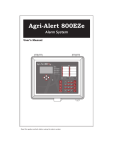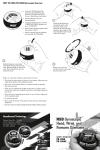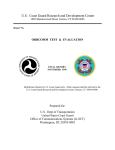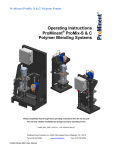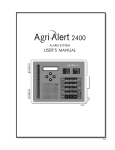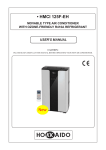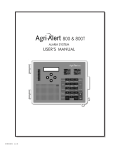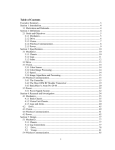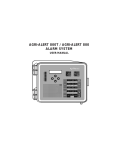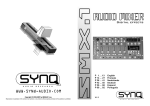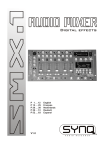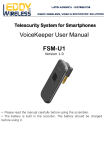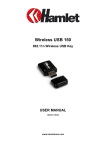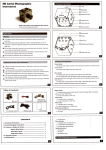Download agri alert 9600_wireless_module_installation user manual
Transcript
WIRELESS MODULE USER’S & INSTALLER’S MANUAL AGRI-ALERT WIRELESS MODULE AGRI-ALERT WIRELESS MODULE Manufacturer: Viatron Electronics 5200, Armand-Frappier St-Hubert (Quebec) Canada J3Z 1G5 WARNINGS The warranty can be void if this product is used in a manner not specified by the manufacturer. Every effort has been made to ensure that this manual is complete, accurate and up-to-date. The information contained in it is however subject to change without notice due to further developments. 2 AGRI-ALERT WIRELESS MODULE rev.03 AGRI-ALERT WIRELESS MODULE Table of Contents 1. System Overview ................................................................................ 4 1.1 Typical Site .................................................................................... 5 1.2 Typical Installation .......................................................................... 6 2 Connecting the Equipment .................................................................... 7 2.1 Supply Inputs .................................................................................. 7 2.1.1 Master Wireless Module .......................................................... 7 2.1.2 Auxiliary Wireless Modules ...................................................... 8 2.1.2.1 Battery Connection ............................................................................. 8 2.1.2.2 Transformer Connection ...................................................................... 8 2.2 Connecting the Earth Ground ............................................................ 9 3 Serial Bus Interface (SBI) Connections .................................................. 10 3.1 Connecting Devices to the Wireless module ..................................... 10 3.2 End of Line Jumpers ...................................................................... 10 4 Installation ........................................................................................ 11 4.1 Mounting Instructions .................................................................... 11 4.2 Antenna Installation ...................................................................... 12 4.2.1 Antenna Mounting Instructions ............................................... 12 4.2.2 Antenna Placement .............................................................. 14 4.2.2.1 Recommended Placement ................................................................... 14 4.2.2.2 Antenna Height ................................................................................. 15 4.2.2.3 Choosing the Mounting Location ........................................................... 16 4.2.3 Verifying the Received Signal Strength Indicator (RSSI) ............. 18 4.2.3.1 Verifying the Signal on the Auxiliary Wireless Module ............................... 18 4.2.3.2 Verifying the Signal on the Agri-Alert 9600 ........................................... 19 5 Controller’s Operation ........................................................................ 20 5.1 Status LEDs ................................................................................. 20 6 Troubleshooting ................................................................................. 21 7 Technical Specifications ..................................................................... 22 8 Wiring Diagram ................................................................................. 24 8.1 Master Wireless Module Powered by an Agri-Alert 9600 ................... 24 8.2 Auxiliary Wireless Module Powered with a Battery and Transformer ... 25 ANNEXE A DEFINING THE RF PATH ....................................................... 26 INDEX ................................................................................................... 27 AGRI-ALERT WIRELESS MODULE rev.03 3 AGRI-ALERT WIRELESS MODULE 1. SYSTEM OVERVIEW The Agri-Alert Wireless module allows transparent wireless communication of the Agri-Alert 9600 alarm system and its sub-modules between livestock buildings. In all, up to 10 barns can remotely communicate together without having to bury wires underground. Hardwired connections usually offer the highest level of reliability. However, in many situations where traditional cabling is problematic, wireless networking can provide an interesting alternative. Why Choose the Agri-Alert Wireless module ? • Easy installation and advanced radio technology will save you time and money; • Overcome the distance and topography problems of hardwire: - Risky digging situations (presence of buried pipes, cables, gas lines, etc.); - Obstacles impede the connection between barns (roads, fields, rivers, etc.); - Barns are a long way apart. • Seamlessly integrate wireless communication with current in-place hardwire. • Use wireless communication to connect a remote distance house to an existing Agri-Alert system. Key to Symbols in the Manual Danger. There is a risk of electrical shock or hazard if the following instructions are not followed. Pay attention. The following text contains very useful information. Caution. Carefully read the following text for it contains important information which, if ignored, may cause the controller to operate improperly. 4 AGRI-ALERT WIRELESS MODULE rev.03 AGRI-ALERT WIRELESS MODULE 1.1 Typical Site The typical site is composed of a master building and auxiliary buildings. All buildings (or hardwired subnetworks) have a Wireless module to communicate with each other using radio frequency (RF) signals. In all, the Agri-Alert Wireless system allows establishing communication between up to 8 buildings (1 master & 7 slaves) at distances as far as 6,500 feet (2 kilometers). The following graphic shows a case where the master building is used in combination with two auxiliary buildings (house & hardwired subnetwork). HOUSE MASTER BARN AUXILIARY BARN HARDWIRED SUB-NETWORK Figure 1 Typical Application There should be only one Master Wireless module per site installation. RADIO To know if your module is a Master or Auxiliary unit, check if there is a M sticker on the radio module. Auxiliary Wireless modules do not have this sticker on their radio. M Figure 2 Master Radio AGRI-ALERT WIRELESS MODULE rev.03 5 AGRI-ALERT WIRELESS MODULE 1.2 Typical Installation Master Building & Master Wireless Module: A site must have one master building that gathers information from other buildings. The master building is the place where the Master Wireless module can be found; this type of module has a radio transmitter that is specially configured to achieve this function. The Master Wireless module is normally used in combination with an AgriAlert 9600 and uses the SBI 28V of the AA9600 system as power source. Hooking up these two devices allows optimizing the overall wireless communication between buildings. Auxiliary Buildings & Auxiliary Wireless Modules: An auxiliary building is a place where an Auxiliary Wireless module can be found; this type of module has a radio transmitter configured to transmit information to the Master Wireless module. In all, up to 10 auxiliary barns (including the house) can be used on a site. Auxiliary modules are self supplied using a transformer and battery box; they are also used to power the alarm system’s sub-modules: TP-800, KBP-400, KP-400, LB-9600 and Relay boxes. House: No distinction is made between barns and houses. In most cases the house is an auxiliary building that has a keypad and an Auxiliary Wireless module. However, it becomes the master building if the AA9600 alarm system and the Wireless module are directly located in the house. HOUSE MASTER BUILDING KP-400 BATTERY BOX WIRELESS MODULE TRANSFO BOX BATTERY BOX AA9600 WIRELESS MODULE SBI SBI AUXILIARY BUILDING BATTERY BOX WIRELESS MODULE DEVICE (TP-800) SBI Figure 3 Typical Installation 6 AGRI-ALERT WIRELESS MODULE rev.03 AGRI-ALERT WIRELESS MODULE 2 CONNECTING THE EQUIPMENT When connecting the equipment to the terminals provided on the main board, strip the wires as little as possible (about 1/4”) to avoid electrical short circuits. Once the wires are connected, run them through the electrical knockouts provided on the bottom of the enclosure and use a watertight cable holders. Additional holes made in the enclosure will void the warranty. Use adequate wire gauges when the Wireless module is placed far from the Agri-Alert sub-modules. 2.1 Supply Inputs 2.1.1 Master Wireless Module The Master Wireless module is generally powered by the 28V SBI of the AA9600 alarm system. Make sure the battery and transformer boxes are properly connected to the AA9600. Do not connect an additional battery and transformer to the Wireless module when the module is hooked up to a AA9600. MASTER WIRELESS MODULE AGRI-ALERT 9600 SUPPLY INPUTS SUPPLY INPUTS SERIAL BUS 1 2 3 4 16VAC BATTERY + DO NOT CONNECT A BATTERY AND TRANSFORMER TO THE WIRELESS MODULE WHEN SUPPLIED BY THE AGRI-ALERT 9600 SYSTEM SERIAL BUS 1 2 3 4 4 5 6 7 16VAC BATTERY + 14 15 16 17 BATTERY BOX REFER TO AA9600’s WIRING DIAGRAM TRANSFO BOX REFER TO AA9600’s WIRING DIAGRAM Figure 4 Master Wireless Module’s Supply AGRI-ALERT WIRELESS MODULE rev.03 7 AGRI-ALERT WIRELESS MODULE 2.1.2 Auxiliary Wireless Modules Auxiliary Wireless Modules are supplied using a 16VAC/40V transformer and a battery box. AUXILIARY WIRELESS MODULE 2.1.2.1 Battery Connection The terminals marked BATTERY are used for the backup battery. The Wireless module uses a 12VDC/5Ah sealed lead acid battery. No other type of battery can be used. The battery wires run through the tube provided (see figure 5). Make sure the positive wire of the battery is connected to the positive terminal. SUPPLY INPUTS 16VAC BATTERY + BATTERY BOX + - DO NOT CONNECT A BATTERY AND TRANSFORMER TO THE WIRELESS MODULE WHEN SUPPLIED BY AN AGRI-ALERT 9600. + 16VAC, 40VA TRANSFORMER + Figure 5 Auxiliary Wireless Module’s Supply BATTERY PROTECTION: The system goes in shutdown mode whenever the battery voltage decreases below the shutdown battery threshold. This may happen when the system runs on the standby battery. The Wireless module does not recharge a battery that has a voltage below 5 Volts or a battery that is connected with reversed polarity. 2.1.2.2 Transformer Connection The terminals marked 16VAC on the main board are used for connecting the 16VAC/40 VA transformer. It must be plugged into a 120VAC/60Hz outlet. Make sure there is no switch on the power outlet. DAMAGE TO THE UNIT MAY OCCUR IF THE TRANSFORMER IS CONNECTED TO THE BATTERY TERMINAL 8 AGRI-ALERT WIRELESS MODULE rev.03 AGRI-ALERT WIRELESS MODULE 2.2 Connecting the Earth Ground Use a rod at least 5/8” (1.6cm) in diameter at least 10’ (3m) long. The rod must have a clean metal surface free of paint, enamel or other nonconducting substances. Drive the rod at least 10’ (3m) into the ground. If the bedrock is more than 47” (1.2m) deep, drive the rod into the ground to bedrock level and bury any remainder horizontally at least 2’ (600mm) below ground level. If the bedrock is less than 47” (1.2m) deep, bury the rod horizontally at least 2’ (600 mm) below ground level (ref. article 10702, 3d of the Canadian Electricity Code C22.10-99). Use a CSA certified wire of TEW type or a UL certified wire of type 1015: Green/yellow, #12AWG, 600V, 105°C insulated wire. We suggest using a Belden #9912 (color code #189) or equivalent. Grounding the Wireless Module Grounding the Lightning Arrestor (when equipped) WIRELESS MODULE Lightning Arrestor (optional) EARTH 2” copper braid 3M METAL ROD 3M METAL ROD METALLIC ROD 2'(0.6M) 10' (3M) The earth ground terminal of Wireless modules and the grounding connection of lightning arrestors must be connected to the earth ground. 10' (3M) 2'(0.6M) >47" (1.2M) <47" (1.2M) 10' (3M) BEDROCK Figure 6 Earth Ground The rod must be connected to the wire described above. It is recommended to let the rod going out of the ground to connect it. The wire length must not exceed 50’ (15m). It is extremely important that the earth ground terminal be connected to a proper ground to protect the electronic components from damage due to lightning surges and electrostatic discharges. Do not use the electrical ground for this purpose. IF OUTDOOR CONNECTIONS ARE USED, MOUNT THE ENCLOSURE AS CLOSE AS POSSIBLE TO THE ENTRY POINT OF THE OUTDOOR WIRING. AN IMPROPER EARTH GROUND CONNECTION IMMEDIATELY VOIDS THE SYSTEM WARRANTY WITHOUT FURTHER NOTICE. AGRI-ALERT WIRELESS MODULE rev.03 9 AGRI-ALERT WIRELESS MODULE 3 SERIAL BUS INTERFACE (SBI) CONNECTIONS 3.1 Connecting Devices to the Wireless module The serial bus interface is used to connect different Agri-Alert devices together. A shielded twisted pair cable is recommended for this purpose. Each device includes four terminals marked SERIAL BUS and numbered from 1 to 4. Connect all the number 1 terminals together, all the number 2 terminals together, etc. as shown in figure 8. SBI Maximum Load = 500mA. A maximum of 6 devices (excluding the Wireless Module) can be connected to the serial bus (SBI). Maximum distance between a wireless module and any device= 500 ft. 3.2 End of Line Jumpers Identify the first and the last device on the communication loop by selecting the “YES” position with the end of line jumpers. For other devices, place the jumper at the NO position. END OF LINE RADIO M COMMUNICATION TERMINALS END OF LINE J8 SBI Figure 7 Location of the End of Line Jumper and Communication Terminals Wireless module END OF LINE YES Serial Bus 1 2 3 4 KPB-400 TP-800 END OF LINE END OF LINE NO Serial Bus 1 2 3 4 NO Serial Bus 1 2 3 4 LB-9600 END OF LINE YES Serial Bus 1 2 3 4 Figure 8 Example of End of Line Jumper Positions and SBI Connections 10 AGRI-ALERT WIRELESS MODULE rev.03 AGRI-ALERT WIRELESS MODULE 4 INSTALLATION 4.1 WIRELESS MODULE Mounting Instructions BATTERY BOX 9 3/8” (23.8 cm) The Wireless module and its 6 3/8” battery (if applicable) should be (16.2 cm) 7 3/8” (18.8 cm) mounted on a wall (see figure 9). 5 7/8” Pull the latch located at the bot(14.9 cm) 4 1/2” (11.4 cm) tom of the boxes to open the enclosures. Use 3/16” diameter screws to mount each enclosure cable cable holder holder on the wall. Fasten the black caps onto the mounting holes once the 6” (15.2 cm) screws are tightened. Make sure plastic tubing the covers of the two boxes can be opened easily. The battery en- Figure 9 Wireless Module and Battery’s Mounting Instructions closure has ventilation openings on the sides. Make sure they are not obstructed. Mount the battery enclosure 4½” from the Wireless module enclosure and use the plastic tubing provided to run the wires from the battery to the module. These wires are provided with the system. The bare end hooks up to the Wireless module. Electrical knockouts are located on the bottom of each enclosure for running the tube. Use a screwdriver and a hammer to punch out the holes. Use the cable holders provided to connect the tube to the enclosure. This prevents water from seeping into the enclosure. Make sure the RF signal is properly received on all Auxiliary Wireless modules before the final fixing of the enclosures on the wall (see section 4.2.4). 1 2 3 4 5 6 Figure 10 Mounting Instructions of the Battery’s Cable Holder AGRI-ALERT WIRELESS MODULE rev.03 11 AGRI-ALERT WIRELESS MODULE 4.2 Antenna Installation 4.2.1 Antenna Mounting Instructions The antenna must be mounted on a rigid PVC pipe. This pipe will then be used to fix the antenna to the building. 1 Punch a 1/2” hole into the PVC end-cap to let the RF cable connector go out as illustrated. 2 Insert the washer and tighten the nut to fix the RF cable connector to the end-cap. 3 Seal the PVC end-cap to the rigid PVC pipe with silicone. WALL CROSS SECTION Antenna PLASTIC CLAMP Lightning Arrestor (optional) BUSHING OR SILICONE approx. 1 inch Bolt & Washer RF CABLE PVC End-Cap RF Cable approx. 6 feet WIRELESS MODULE 90° FITTING 1/2” Rigid PVC Pipe MIN 6” Figure 11 Antenna Installation 12 AGRI-ALERT WIRELESS MODULE rev.03 AGRI-ALERT WIRELESS MODULE 4 Run the RF cable through a 1/2” diameter rigid PVC pipe. This pipe will be used as a support for the antenna. Make sure it is long enough (about 6 feet). 5 If required, connect the optional lightning arrestor to the antenna. This device protects the system from damage by intercepting flashes of lightning and transmitting their current to the ground. Refer to section 2.2 to ground the lightning arrestor. If no lightning arrestor is used, connect the antenna directly to the RF cable. 6 Connect the antenna to the RF cable connector. DO NOT TWIST THE NON-ROTATABLE SECTION OF THE RF CONNECTOR! 7 Connect the other end of the RF cable to the Wireless module. DO NOT KINK OR OVERTIGHTEN THE RF CABLE AGRI-ALERT WIRELESS MODULE rev.03 13 AGRI-ALERT WIRELESS MODULE 4.2.2 Antenna Installation 4.2.2.1 Recommended Positions The best antenna location is at one edge of the top of the roof as illustrated below. In this situation, the antenna must be at least 2 feet higher than the roof peak. 2’ RF CABLE RF CABLE M A AA9600 & other devices SBI Master Wireless Module Devices SBI Auxiliary Wireless Module Figure 12 Recommended Antenna Position 1 Another possibility is to install the antenna on the roof cornice. However, in this case, the antenna must be at least 4 to 6 feet higher than the cornice. Make sure the roof does not impede the RF signal transmission. 4 to 6’ RF CABLE Master Wireless Module + AA9600 & other devices RF CABLE Auxiliary Wireless Module & other devices Figure 13 Recommended Antenna Position 2 14 AGRI-ALERT WIRELESS MODULE rev.03 AGRI-ALERT WIRELESS MODULE 4.2.2.2 Antenna Height The height of an antenna basically depends of the following factors: Distance Between Buildings: The longer the link, the higher the antenna needs to be. Line of Sight (LOS) & RF Path: All antennas must be mounted in order to have a direct line of sight with the antenna of the master module. This direct line of sight is only possible when all antennas have about the same height above mean-sea-level. In addition, the area around the visual line of sight – the RF path – must be clear from obstacle or else signal strength will be degraded. Figure 14 RF Path Antenna Height & RF Path Clearance: The height of the antennas must ensure a complete clearance of the RF Path. This path has an elleptical shape and is defined based on the greater distance that separates any two buildings on site. Take the greater distance between two buildings and then refer to the table in Appendix A at the end of this manual to see what RF clearance must be respected. This clearance must be present at the midway point between the buildings, above and below the line of sight (see picture above). Determine the antenna height accordingly. PRECAUTIONS: Do not install the antenna higher than recommended unless immovable objects are in the RF path. Support cables may also be required to fix the antenna pole in place. The antenna height must not exceed 4 feet above the roof peak; otherwise, it may become a target for lightning. If you are unable to meet the recommended antenna height requirement, please get professional help. AGRI-ALERT WIRELESS MODULE rev.03 15 AGRI-ALERT WIRELESS MODULE 4.2.2.3 Choosing the Mounting Location Before attempting to install your antenna, determine where you can best place it to obtain optimum results. Best performance is achieved when all antennas are close to each other, mounted at the same height, and in a direct line of sight with no obstruction in the RF Path. Some examples are illustrated on next page. STEP 1: Make an overview diagram of the particular site. Include the following elements: • • • Location and orientation of the buildings; Distance between buildings; Obstacles (trees, bins, roads, fields, etc.) STEP 2: Determine the antenna location of each building based on the following requirements: Make sure the RF signal is properly received by all Wireless modules before fixing any equipment. Refer to section 4.2.3 to verify the received signal strength. a) Find a mounting place directly above your Wireless module so that the RF cable can be as short as possible. The provided RF cable has a total length of 25ft (7.6m). If you need to use a longer cable, please contact your retailer. b) Identify the master building. This building is ideally located in the site’s median zone, at equal distance from other buildings. Note that the distance between the Master Wireless module and the Agri-Alert devices must not exceed 500ft (150m). c) Identify the location of the AA9600 (it can either be located in the master building or in the master building’s hardwired subnetwork). d) Write down the required antenna height (as defined in Appendix A). e) Make sure the distance between any Wireless building never exceeds 6,500 ft (2 km). f) Determine the antenna position for each building. Make sure no obstacle blocks the RF signal transmission (roof, trees, bins, etc.) It may be required to cut down trees or to relocate any element that impedes the direct line of sight between antennas. If you are unable to meet these requirements, please get professional help. 16 AGRI-ALERT WIRELESS MODULE rev.03 AGRI-ALERT WIRELESS MODULE INCORRECT - No direct Line of sight (LOS) - Presence of objects in the path CORRECT - Direct Line of sight (LOS) - No object in the path BAD CORRECT BAD CORRECT BAD CORRECT Figure 15 Examples of Antenna Placement AGRI-ALERT WIRELESS MODULE rev.03 17 AGRI-ALERT WIRELESS MODULE 4.2.3 Verifying the Received Signal Strength Indicator (RSSI) Before making any permanent installation, you must make sure the radio frequency (RF) signal is properly received in each auxiliary building. Status leds indicating the received signal strength (RSSI) are located on the circuit board of each Wireless module. These pilot lights indicate how well Auxiliary Wireless module communicate with the Master Module. RSSI LEDS RSSI EXCLNT GOOD FAIR WEAK RADIO It is also possible to check the communication statistics directly on the AA9600 system (see section 4.2.3.2). Figure 16 RSSI LEDs’ Location 4.2.3.1 Verifying the Signal on the Auxiliary Wireless Module Check the RSSI on the Auxiliary Wireless only (the signal strength on the Master module is not suitable). At least 2 RSSI LEDs must be lit on each Auxiliary wireless module for the system to have accept able performances (Fair signal reception). M SBI MASTER BUILDING a) Choose a fix location for the Master Wireless module and its antenna. Antenna positions in auxiliary buildings will be based on the master building. b) Power the Master Wireless module and the AA9600 unit. AUXILIARY BUILDING c) Mount a second antenna on rigid PVC pipe and connect it to an Auxiliary Wireless module. d) Power the Auxiliary module using a battery. e) Position the antenna next to the auxiliary building and verify the received signal strength. Permanent antenna installation can be performed if at least two RSSI LEDs are lit. 18 AGRI-ALERT WIRELESS MODULE rev.03 Figure 17 Verifying the Received Signal Strength AGRI-ALERT WIRELESS MODULE 4.2.3.2 Verifying the Signal on the Agri-Alert 9600 (Advanced function) On the AA9600 : 1. Press the System key. 2. Enter the installer’s password (9601 by default) and press Enter . 3. Select the PROGRAM AUX’S menu and press Enter. SYSTEM PROGRAM AUX’S 4. Select the INFORMATION menu and press Enter. PROGRAM AUX’S INFORMATION 5. Enter the number associated with the device you want to access from a remote location and press Enter. SELECT DEVICE (1..99): _ _ 6. Communication statistics on the selected device are displayed: the Loss value repesents the number of packet loss and the Total represents the number of sent packets (the total value automatically goes back to 0 once it reaches 65000 or after a reset) KP#02 ZONE 22,23,24,25 LOSS: 0 TOTAL: 0 7. Press the right-arrow key to reset the communication statistics. KP#02 ZONE 22,23,24,25 LOSS: ## TOTAL: 500 8. Wait until the total number of packets reaches 500 and check the number of packet loss at that moment. In an excellent installation, the amount of packet loss would be of 15 out of 500 or less (3% loss). This loss rate is only reached in perfect conditions, an application can be functional with a higer packet loss rate. If you want to improve your communication statistics, try relocating the antennas and make sure the cables are in good working conditions. AGRI-ALERT WIRELESS MODULE rev.03 19 AGRI-ALERT WIRELESS MODULE 5 CONTROLLER’S OPERATION 5.1 Status LEDs Pilot lights are located onto the circuit board of the Wireless Module. The following table gives the meaning of each status LED. LED RSSI (Received signal strength indicator) MEANING EXCLNT Received signal is excellent. GOOD Received signal is good. FAIR Received signal is fair (m inimum acceptable signal). W E AK Received signal is weak. LOW B AT Turns on when the battery voltage is lower than 11 Volts AC ON Turns on when the controller is powered with a valid 16VAC source. SBI IN VOLT. Turns on when the controller is supplied by an Agri-Alert 9600 or when it runs on the battery only. SBI OUT VOLT. Turns on when the controller is supplied by a transformer. SBI TX DATA Blink when the controller is sending / receiving data. SBI RX DATA RF PRESENT LED in the Master W ireless module: Turns on when the Master is operating correctly RF PRESENT RF PRESENT LED in the Auxiliary W ireless module: Turns on when the Auxiliary W ireless module detects the presence of the Master W ireless module. Table 1 Status Leds Led Test To make sure the pilot lights are in working order, unplug and replug the Wireless module: an automatic LED test is performed when power is applied to the controller. Make sure all LED light up. NB. The RF PRESENT led is not tested during the LED test. 20 AGRI-ALERT WIRELESS MODULE rev.03 AGRI-ALERT WIRELESS MODULE 6 TROUBLESHOOTING PROBLEM CAUSE 1. Check the wiring between the AA9600 and the W ireless Module's sub-modules. TROUBLE between AA9600 and a sub-module of a W ireless Module 2. Make sure the W ireless module provides sufficient voltage to the devices: The SBI IN VOLT or SBI OUT VOLT LED located on the circuit board of each Auxiliary W ireless module 1. Make sure no objects are present in the RF path. 2. Make sure all antennas have a direct line of sight with each other. Weak received signal (RSSI) 3. Try increasing the height of the antenna. 4. Make sure the antenna, RF Cable, cable connection, and Radio are in proper working condition. 1. Check the wiring. 2. Make sure the Auxiliary and Master W ireless modules are properly powered. No signal is received (RSSI) on an Auxiliary W ireless module 3. Make sure all antennas have a direct line of sight with each other. 4. Make sure no objects are present in the RF path. 5. Make sure the antenna, RF Cable, cable connection, and Radio are in proper working condition. The W ireless Module shuts down (when AC source is absent) The battery's voltage decreased below 9.3 Volts. Make sure the battery is connected properly and is in good working condition. The battery voltage decreased below 11V. LOW B A TT LED turns on and AC source is ok The RSSI LED is lit on an Auxiliary W ireless module while the Master W ireless module is turned off. The battery is currently being recharged unless it is improperly connected. Verify the battery connection and make sure it is in good working condition. Other RF signals are emitted in the surrounding area. Try to find out the source of these signals (wireless phones, routers, or any devices using the ISM 2.4GHz band). AGRI-ALERT WIRELESS MODULE rev.03 21 AGRI-ALERT WIRELESS MODULE 7 TECHNICAL SPECIFICATIONS GENERAL 22 Maximum Power Consumption 5.0V 500 mA (board supply) 16.0V 500 mA (SBI Voltage) 13.8V 600 mA (Current Limited Battery charger) Total of 34Watts per module Backup Battery 12V,5AH sealed lead/acid battery Battery Charging time 10 Hours Maximum (For fully discharged batteries) Battery autonomy 5 Hours Typical (With maximum load & fully charged battery) Supply Transformer 16VAC, 2.25A, 40VA, Wall Plug-in Transformer Onboard Supplies +5VDC ±2%, ±20 mV ripple (Radio & electronics) +16VDC ±2%, ±50 mV ripple (SBI Voltage) +13.8VDC ±2%, ±50 mV ripple (Battery charger) +23VDC Unregulated ±10%, ±150 mV ripple Onboard Protection Gas tube, Spark gap, polyswitch and over voltage protection SBI Serial Interface RS-485, 2 wires, half duplex SBI Serial Interface Data Rate Single channel at 9600 bps SBI 28V Supply Output 16 VDC 500mA or Batteries voltage SBI Bus Maximum Output Range 500 feet range (with 6 SBI loads and 22 AWG wires) LO Batteries Alarm LED LO BAT LED ON -> Batteries level under 11V LO BAT LED OFF -> Batteries level above 11V Antenna Type 5dBi Whip type, Omni-directional Antenna With Reverse Polarity TNC connector Antenna RF Cable TNC Male Plug to RP-TNC (Reverse Polarity) Male Jack, 25 feet cable: 1-25 feet LMR-195 (Cable Loss of 4.65dB @ 2.4GHz) Antenna Lighting Arrestor RP Male/Female TNC, 30 kA Multiple strike MAXRAD Model: MLP24RPC AGRI-ALERT WIRELESS MODULE rev.03 AGRI-ALERT WIRELESS MODULE RADIO Frequency Band US/Canada: 2.402 - 2.478 GHZ France: 2.448 - 2.457 GHZ Radio Type Frequency Hopping Spread Spectrum, ISM Band Radio Output Power (At box coaxial connector) +23 dBm (200 mW typical) Sensitivity -90 dBm typical Wireless Maximum Range (5 dBi gain antenna & 5 dB loss RF cable) Outdoor (With Direct Line of Sight): 2 km/ 6562 ft Indoor (Open Area): 200 m/ 650 ft RF Transmission Latency 10ms typical (each way) Radio Architecture Point to Multipoint with Broadcast support & packet validation RF Data Rate 80 kbps (Half duplex, with Acknowledge) Radio model Aerocomm model: AC4424-200 ENVIRONMENTAL Operating Temperature Wireless Module: 0°C to+50°C Antenna & RF Cable only: -40°C to +50°C Water Resistant Yes AGRI-ALERT WIRELESS MODULE rev.03 23 24 AGRI-ALERT WIRELESS MODULE rev.03 + 16VAC BATTERY SUPPLY INPUTS BATTERY BOX REFER TO AA9600’s WIRING DIAGRAM AA9600 TRANSFO BOX REFER TO AA9600’s WIRING DIAGRAM ANTENNA RF CABLE SERIAL BUS 1 2 3 4 BATTERY + WARNING NOT USED * 16VAC SUPPLY INPUTS MASTER WIRELESS MODULE 3M METAL ROD SERIAL BUS 1 2 3 4 DEVICE KP-400, KPB-400 LB-9600, TP-800 OR RELAY BOX DO NOT CONNECT A BATTERY AND A TRANSFORMER TO THE WIRELESS MODULE WHEN USED IN COMBINATION WITH A AGRI-ALERT 9600 SYSTEM NOT USED NC COM NO EARTH LOW BATTERY RELAY Master Wireless Module Powered by an Agri-Alert 9600 AGRI ALERT 9600 SERIAL BUS 1 2 3 4 8.1 8 WIRING DIAGRAM SERIAL BUS 1 2 3 4 DEVICE KP-400, KPB-400 LB-9600, TP-800 OR RELAY BOX AGRI-ALERT WIRELESS MODULE SERIAL BUS 1 2 3 4 16VAC 40VA TRANSFORMER BATTERY + SUPPLY INPUTS 16VAC BATTERY BOX + NOT USED 3M METAL ROD NC COM NO EARTH LOW BATTERY RELAY SERIAL BUS 1 2 3 4 DEVICE DEVICE SERIAL BUS 1 2 3 4 KP-400, KPB-400 LB-9600, TP-800 OR RELAY BOX KP-400, KPB-400 LB-9600, TP-800 OR RELAY BOX Auxiliary Wireless Module Powered with a Battery and Transformer AUXILIARY WIRELESS MODULE 8.2 AGRI-ALERT WIRELESS MODULE AGRI-ALERT WIRELESS MODULE rev.03 25 AGRI-ALERT WIRELESS MODULE ANNEXE A DEFINING THE RF PATH The RF path is an area around the visual line of sight that must be clear from obstacle or else signal strength will be degraded. This path has an elleptical shape and is defined based on the greater distance that separates any two buildings on site. It is important to know what the RF Path is in order to determine the height at which the antennas must be mounted. To define the path, take the greater distance that separates 2 buildings and then refer to the table below to know what RF Clearance must be present at the midpoint between the buildings. The RF Clearance must be present above and below the line of sigth as shown below. Maximum distance between buildings Suggested RF Clearance 1.25 miles (2.0km) 23ft (7m) 0.93 miles (1.5km) 20ft (6.1m) 3200 ft (1.0km) 16.5 ft (5m) 1600 ft (500m) 13 ft (4m) 985 ft (300m) 10 ft (3m) 165 ft (50m) and lower 7 ft (2m) Table 2 RF Clearance Figure 18 Antenna Height vs Distance Between Buildings 26 AGRI-ALERT WIRELESS MODULE rev.03 AGRI-ALERT WIRELESS MODULE INDEX A M Antenna Mounting instructions 12 Placement Choosing a right placement 16 Examples 17 Height 15 Recommended placement 14 Received signal strength 18 Auxiliary Wireless see also Wireless module Definition & location 6 Identification 5 Received signal strength (RSSI) 18 Supply inputs 8 B Battery Connection 7, 8 Mounting instructions 11 Buildings Auxiliary building 6 House 6 Master building 6 C Connections 23, 24 D Master Wireless see also Wireless module Definition & location 6 Identification 5 Supply Inputs 7 R Received signal strength (RSSI) 18 Relay Box see Devices S Serial bus interface (SBI) 10 Signal see Received signal strength Status leds see LEDs T TP-800 see Devices Transformer Connection 7, 8 W Wireless module Earth grounding 9 End of line identification 10 Mounting instructions 11 Wiring diagram 23, 24 Devices (sub-modules) Connection 10 End of line identification 10 E Earth Ground 9 End of line identification 10 H House 6 J Jumpers End of line jumpers 10 K KP-400 see Devices KPB-400 see Devices L LB-9600 LEDs see Devices LED Meaning 19 Lightning arrestor Earth ground connection 9 Location 12 Ligths see Leds AGRI-ALERT WIRELESS MODULE rev.03 27 M 890-00031 rev. 03 REV. 02





























